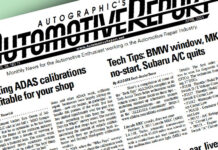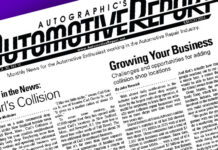By John Yoswick
For a growing percentage of the industry, it’s hard to remember a time before the daily role websites are playing in American’s work and personal lives. And although there’s no shortage of sites vying for your attention, there are certainly some that offer more of an impact on your collision repair business.
Here are thirteen such websites you may want to keep among your ‘favorites’ to use on an occasional or regular basis.
1. National job board
Employers in the automotive aftermarket can post job openings on a new national online job board (http://jobs.autocarecareers.org/) created by the Auto Care Association.
The site also offers a variety of other information and tools to help employers in the automotive aftermarket recruit or develop the talent they need.
2. Source for all OEM info
There’s no actual OEM repair information at the www.OEM1stop.com (or www.OemOneStop.com) website, but the site’s single page offers you links to every automaker’s technical repair information website. Just click on any of the 37 automaker logos on the website, indicate whether you need collision or mechanical repair information, and you’ll be taken directly to that automaker’s information website.
3. Collision-specific OEM info help
If you’ve visited an automaker’s website and just can’t seem to find the sectioning or other collision repair information you need, your next stop should probably be I-CAR’s “Repairability Technical Support Portal” (https://rts.i-car.com/). It’s loaded with collision repair information — and a unique service to help you out if what you need still eludes you.
A “collision news” section of the portal includes three or four new articles a week; this is where, for example, I-CAR announced in 2014 that Kia Motors finally released comprehensive collision repair manuals in the United States for the first time. More recently, more than four dozen collision repair instruction sheets for the 2015 Ford F-150 were added to the site. Shops and technicians can sign up for “push notifications” about any such news posted to the portal by following the “@tech_briefs” Twitter feed.
Perhaps best of all, the portal offers an “Ask I-CAR” feature, a way for users to email or call I-CAR with a technical question for which they haven’t been able to find an answer. One user, for example, told “Ask I-CAR” that he couldn’t find the sectioning procedures for the B-pillar on a Dodge Dart; within minutes, the I-CAR representative had checked the Dodge OEM information website and found that, given the type of steel used for that B-pillar, Dodge offers no sectioning procedures. All the questions and responses processed through “Ask I-CAR” are posted in a searchable (by year-make-model) database on the site.
I-CAR’s Steve Marks said questions related to sectioning are among the most common received through the portal.
“We will tell them if there is a procedure available or not, and if the information is publicly available, we will supply it to them,” Marks said.
If the procedure is not available, I-CAR will attempt to get information from the automaker. If the procedure is available but only through the fee-based website operated by the automaker, Marks said, I-CAR will refer the person asking the question to that site.
I-CAR CEO John Van Alstyne said in the first six months after the portal was launched, it received 75,000 hits and 914 “Ask I-CAR” inquiries.
“Apparently we’re filling a need,” Van Alstyne said. “There’s demand for this information and we’re happy to see that.”
4. Lots of free tools and forms
As a former shop owner and now full-time trainer and consultant, Mike Anderson of Collision Advice has his finger on the pulse of the industry as well as anyone. But even for those not attending one of his classes or engaging his consulting services, Anderson’s website (www.CollisionAdvice.com) offers a treasure trove of sample forms and estimating and shop management tools — all at no cost (the site does ask you to provide an email address to access the resources).
Need a sample of a form to use when checking in a vehicle? A form to use to issue a written disciplinary warning to an employee? Wording for your written warranty? Tools to help with your negotiations with insurers over estimate line items? It’s all there.
Collision Advice also conducts quarterly surveys asking shops around the country what not-included repair procedures they ask to be paid for — and how frequently various insurers pay for those procedures. Shops can sign up to participate in the surveys and get information about the results of previous surveys, by clicking on the “Who Pays for What” logo on the Collision Advice home page.
5. Good social media content
Looking for driver-safety content to include on your shop’s website or Facebook page? The National Highway Traffic Safety Administration (NHTSA) offers a website (http://www.trafficsafetymarketing.gov/) packed with such information and logos ready for use, all at no charge. The site can help you offer customers and potential customers information on distracted driving, driving tips for elderly drivers, child car safety, etc.
6. State-by-state regulatory help
As part of the work of the Collision Industry Conference (CIC) “Definitions Committee,” a new website is under development to help shops meet and comply with federal, state and local regulations. The in-process website (www.ciccomplyandsustain.com) will eventually give shops state-by-state assistance with environmental and worker safety compliance regulations and sustainability assistance. Though not yet complete, it already offers plenty of good information and links for shops.
7. A way to address ‘steering’
Tony Passwater of the Indiana Auto Body Association last year created a website (www.iHaveBeenSteered.com) — as well as a toll-free phone number (855-No-2-STEERing) — to allow consumers anywhere in the country to describe their interactions with an insurer related to shop choice. Passwater said consumers who may be hesitant to fill out a “complaint form” may be more likely to more casually “share what their experience has been.”
8. Good info for your customers
The OEM Roundtable has created a consumer website (www.CrashRepairInfo.com) shops can use to help educate their customers. It includes information on how to choose a body shop; definitions of common terms used in collision repair and auto insurance claims; automaker position statements on reconditioned wheels, vehicle safety systems, counterfeit or salvage airbags, etc.; and videos such as Honda’s demonstration of a mistimed airbag’s impact on a watermelon.
9. Help improve the estimating systems
Think a labor time in one of the estimating databases is inadequate? Unclear about what’s included and not-included in a labor time? Think there’s other information that’s incorrect or missing in an estimating system? It’s time to visit the Database Enhancement Gateway (DEG) (www.DEGweb.org).
There, anyone in the industry can quickly post an inquiry related to the estimating system databases. Launched in 2007 and funded largely by three repairer trade associations, the DEG is designed to get your inquiry in front of the appropriate estimating system provider for a response. Those responses — many of which include changes to labor times — are posted in the DEG database. That database now includes more than 8,800 inquires.
Although such inquiries can always be made directly to the estimating system provider, the DEG simplifies and standardizes the inquiry process. It involves little more than filling out a brief form identifying the vehicle, the area or part of the vehicle involved, and including one or two sentences explaining what information you feel is missing or inaccurate in one of the estimating databases. Photos can be submitted as well. The DEG gives the entire industry access to the information the estimating system providers offer in their responses.
Although the entire process can sometimes be completed in just one or two days, some inquiries require more research (the database of inquiries on the DEG website lists the resolution time for each).
What have DEG inquiries helped accomplish? Just a few examples:
• Inquiry No. 3,462, submitted in 2011, pointed out to Audatex (now AudaExplore) that Toyota’s repair manual says that the first step in replacing the steering gear on a 2010 Toyota Tundra is to remove the engine. The inquiry asked Audatex to note this in its database and indicate that the labor time for the operation is after engine removal. Audatex did more than just add a note; it changed the labor time for the operation from 2.4 hours to 13.4 hours to include the engine removal operation.
• Inquiry No. 1,901, submitted in 2009, was triggered when an estimator felt the labor allowance for removal and replacement of vehicle name plates seemed insufficient to cover cleaning up all the adhesive that is left behind after removal. Mitchell International confirmed that the time does not include cleaning and re-taping of nameplates or adhesive exterior trim.
• Inquiry No. 5,601, filed in 2013 was about missing information in Motor’s estimating database (which is used by CCC Information Services) for the 2013 SCION FR-S; resulted in 39 parts for that vehicle now being identified in the database as single-use or non-reusable.
The DEG website offers other helpful information as well. No estimator should be without a copy of the estimating guides (often referred to as “P-pages”) for all the estimating systems. Understanding these guides is a must in order to write a complete and accurate estimate in the system(s) you use, or to audit an estimate that has been written in a system you don’t use. All three can be downloaded at no charge from the “Get Educated” section on the DWG website.
10. Keep up with legislation
Unsure what the laws in your state are regarding use of non-OEM parts? Need to file a complaint with your state insurance regulator? Want a quick way to contact your members of Congress? All of this information is available at the Automotive Service Association (ASA) legislative website: www.TakingTheHill.org. Sign up at the site to be kept informed about legislative or regulatory issues impacting our industry, often with links to ready-to-sign letters that will be sent to your district’s elected leaders.
11. Help from paint manufacturers
Want to know what the manufacturer of the line of paint you spray says about the need for shops to do final sand and polish? Or about blending clearcoat? The Society of Collision Repair Specialists (SCRS) has collected statements from all of the paint companies on these and other topics that may be helpful for shops in their negotiations with insurers. They’re all posted to the association’s website (http://scrs.com/index.php?id=refinish-manufacturer-technical-information).
12. Get the latest industry news
Did you know you can read the content from this and previous issues of this publication on Automotive Report’s recently-revamped website (http://www.automotivereport.net/)? From feature stories and columns to a ticker of industry news, the website offers current happenings as well as an archive of past issues.
13. Tell State Farm your rates
Shops in some markets last fall experienced changes in the labor rates State Farm was willing to pay after the insurer redefined the geographic boundaries it uses to establish prevailing rates. State Farm didn’t disclose much in the way of details of the changes, saying only that it wanted the geographic boundaries to more closely align with “government-defined market areas.” The change led to increases in “prevailing competitive price” in some markets and decreases in others, although the majority of shops reported no change.
One thing that didn’t change is the system State Farm uses to establish that “prevailing competitive price.” It’s all up to shops to visit the insurer’s business-to-business website (https://b2b.statefarm.com/b2b/index.html) to report their current rates. Until one or more shops in a market report an increase, a change in the prevailing rate isn’t likely to happen in that market. •
John Yoswick, a freelance writer based in Portland, Oregon, who has been writing about the automotive industry since 1988, is also the editor of the weekly CRASH Network (for a free 4-week trial subscription, visit www.CrashNetwork.com). He can be contacted by email at jyoswick@SpiritOne.com.



